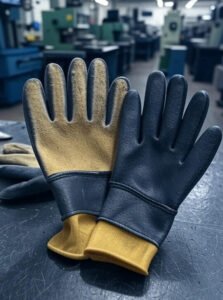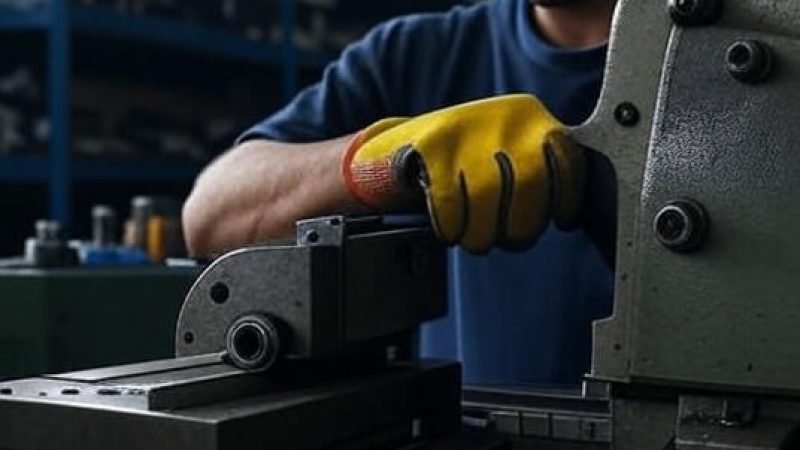What are Safety Gloves Used for in the Machine Shop?
Table of Contents
Introduction
Safety gloves are indispensable personal protective equipment (PPE) in machine shop environments, where workers face numerous hand-related hazards daily. From handling sharp metal components to exposure to cutting fluids and hot surfaces, machine shops present unique challenges that require specialized hand protection solutions.
Understanding the specific applications and benefits of safety gloves in these industrial settings is crucial for maintaining workplace safety, preventing injuries, and ensuring regulatory compliance. Quality manufacturers in the industry continue to develop innovative protective solutions that address the evolving needs of modern machine shops.
Essential Functions of Safety Gloves in Machine Shops
Protection Against Sharp Objects and Cuts
The primary function of safety gloves in machine shops is protecting workers’ hands from cuts and lacerations. Machine operators regularly handle sharp metal edges, cutting tools, burrs, and fabricated components that can cause severe injuries without proper protection.
Modern cut-resistant gloves utilize advanced materials such as ultra-high molecular weight polyethylene (UHMWPE) fibers, providing exceptional protection while maintaining the flexibility needed for precise work. These gloves are rated according to ANSI/ISEA standards, with protection levels ranging from A1 to A9, allowing shops to select appropriate protection for specific tasks.
Key benefits include:
- Prevention of lacerations from sharp metal edges
- Protection during tool handling and maintenance
- Reduced risk of puncture wounds from metal shavings
- Enhanced safety during material handling operations
Chemical and Oil Resistance
Machine shops utilize various chemicals, including cutting fluids, coolants, oils, solvents, and degreasers. Safety gloves provide essential barrier protection against these substances, preventing skin irritation, chemical burns, and harmful absorption through the skin.
Chemical-resistant gloves made from materials like nitrile, neoprene, or PVC offer varying levels of protection depending on the specific chemicals present in the work environment. This protection is particularly important when handling petroleum-based products and metalworking fluids that can cause dermatitis and other skin conditions.
Heat and Burn Prevention
Machine operations generate significant heat through various processes including cutting, grinding, welding, and friction from high-speed machinery. Heat-resistant gloves protect against burns from hot surfaces, sparks, and molten metal splatter.
These specialized gloves often feature aramid fibers, leather construction, or aluminized materials that provide thermal insulation while maintaining adequate dexterity for precision work. They’re essential when handling freshly machined parts, performing welding operations, or working near heat treatment equipment.

Enhanced Grip and Control
Safety gloves significantly improve grip strength and control, which is crucial for safe machine operation. Textured palm surfaces, specialized coatings, and ergonomic designs enhance the handling of tools and components, reducing the risk of drops and slips that could cause injuries or damage expensive equipment.
Advanced glove designs balance protection with tactile feedback, allowing workers to maintain sensitivity for detailed assembly tasks and precision machinery operation while ensuring adequate protection.
Types of Safety Gloves for Machine Shop Applications
Cut-Resistant Gloves
Cut-resistant gloves form the foundation of hand protection in most machine shop applications. These gloves incorporate high-strength synthetic fibers that resist cutting forces while maintaining flexibility and comfort.
Features and applications:
- UHMWPE or aramid fiber construction
- Various protection levels (A1-A9 ratings)
- Reinforced palm areas for enhanced durability
- Suitable for metal fabrication, assembly, and material handling
- Available in different thicknesses to balance protection and dexterity
Leading manufacturers like Jubaomachine have developed specialized cut-resistant gloves that meet the demanding requirements of modern machine shops, offering superior protection without compromising worker productivity.
Chemical-Resistant Gloves
Chemical-resistant gloves protect against the wide array of substances commonly found in machine shop environments. The choice of glove material depends on the specific chemicals present and their concentration levels.
Common materials and applications:
- Nitrile: Excellent resistance to oils, fuels, and many chemicals
- Neoprene: Broad chemical resistance with good flexibility
- PVC: Cost-effective option for light chemical exposure
- Butyl rubber: Superior protection against ketones and esters
These gloves are essential when handling cutting fluids, cleaning solvents, rust preventatives, and other chemical substances used in machining operations.
Heat-Resistant Gloves
Heat-resistant gloves address the thermal hazards present in many machine shop operations. These gloves must withstand high temperatures while providing adequate insulation and maintaining necessary dexterity.
Types and applications:
- Aramid fiber gloves for extreme heat resistance
- Leather gloves for welding and general heat protection
- Aluminized gloves for radiant heat protection
- Silicone-treated gloves for enhanced grip at high temperatures
Proper temperature rating selection is crucial, as exceeding the glove’s thermal limits can result in failure and serious burns.
Multi-Purpose Work Gloves
General-purpose work gloves provide basic protection for routine machine shop tasks that don’t require specialized protection. These versatile gloves typically feature synthetic leather palms, padded knuckle protection, and adjustable wrist closures.
While not designed for specific hazards, these gloves offer reliable protection for material handling, equipment maintenance, and general shop work where cut, chemical, or heat resistance isn’t the primary concern.
Choosing the Right Safety Gloves
Selecting appropriate safety gloves requires careful evaluation of several critical factors:
Hazard Assessment: Conduct a thorough analysis of all potential hand hazards in your specific work environment, including cut risks, chemical exposure, temperature extremes, and impact dangers. This assessment guides the selection of appropriate protection levels and materials.
Comfort and Fit: Properly fitting gloves ensure maximum protection and user compliance. Gloves should fit snugly without restricting circulation or movement. Consider using sizing charts from reputable manufacturers to ensure proper fit across diverse hand sizes.
Dexterity Requirements: Balance protection needs with the dexterity required for specific tasks. Fine motor skill work may require thinner gloves with lower protection levels, while heavy fabrication can accommodate thicker, more protective options.
Duration of Use: Consider how long workers will wear gloves continuously. Extended wear requires breathable materials and ergonomic designs to prevent fatigue and maintain comfort throughout work shifts.
Cost-Effectiveness: Evaluate total cost of ownership, including purchase price, durability, and replacement frequency. Higher-quality gloves often provide better long-term value through extended service life and superior protection.
Regulatory Compliance: Ensure selected gloves meet relevant OSHA requirements and industry standards for your specific applications.
Best Practices for Glove Usage
Implementing effective glove programs requires establishing proper usage protocols and maintenance procedures:
Pre-Use Inspection: Workers should inspect gloves before each use, checking for cuts, tears, chemical degradation, or other damage that could compromise protection. Any damaged gloves must be replaced immediately.
Proper Training: Provide comprehensive training on correct glove selection, proper donning and doffing procedures, and recognition of when gloves need replacement. This training should be reinforced regularly and updated when new glove types are introduced.
Cleaning and Maintenance: Many safety gloves can be cleaned and reused, extending their service life. Follow manufacturer recommendations for cleaning methods and storage conditions to maintain glove integrity.
Replacement Scheduling: Establish replacement schedules based on usage patterns, manufacturer recommendations, and observed wear patterns. Regular replacement ensures consistent protection levels and prevents unexpected glove failure.
Companies like Jubaomachine often provide detailed usage guidelines and maintenance recommendations to help shops maximize the effectiveness and lifespan of their protective equipment.

Industry Standards and Compliance
Safety gloves must meet specific industry standards and regulatory requirements to ensure adequate protection:
ANSI/ISEA Standards: The American National Standards Institute (ANSI) and International Safety Equipment Association (ISEA) establish performance standards for protective gloves, including standardized cut resistance testing (ANSI/ISEA 105) and puncture resistance requirements.
OSHA Compliance: The Occupational Safety and Health Administration requires employers to provide appropriate PPE when workplace hazards cannot be eliminated through engineering controls. This includes hand protection that meets the specific hazards present in the workplace.
EN Standards: European Norm standards provide additional performance benchmarks, particularly relevant for companies operating internationally or using European-manufactured equipment. These standards often complement or exceed ANSI requirements.
ISO Standards: International Organization for Standardization guidelines provide globally recognized benchmarks for glove performance and testing procedures.
Quality manufacturers ensure their products meet or exceed these standards, providing proper documentation and certifications that demonstrate compliance with safety requirements.
Conclusion
Safety gloves serve multiple critical functions in machine shop environments, providing essential protection against cuts, chemical exposure, heat, and other workplace hazards while enhancing worker productivity through improved grip and control. The selection of appropriate gloves requires careful consideration of specific workplace hazards, comfort requirements, dexterity needs, and regulatory compliance.
Investment in high-quality safety gloves from reputable manufacturers represents a crucial component of comprehensive workplace safety programs. Proper implementation of glove selection, training, and maintenance protocols ensures maximum protection for machine shop workers while supporting productivity and regulatory compliance.
As machine shop technologies and processes continue to evolve, safety glove designs will advance to meet new challenges while maintaining the fundamental goal of protecting workers’ hands. Regular review and updating of hand protection programs, including evaluation of new products from innovative manufacturers like Jubaomachine, ensures continued effectiveness in preventing workplace injuries and maintaining safe working environments.
The commitment to proper hand protection not only prevents injuries and reduces costs but also demonstrates a company’s dedication to worker safety and operational excellence in today’s competitive manufacturing environment.
